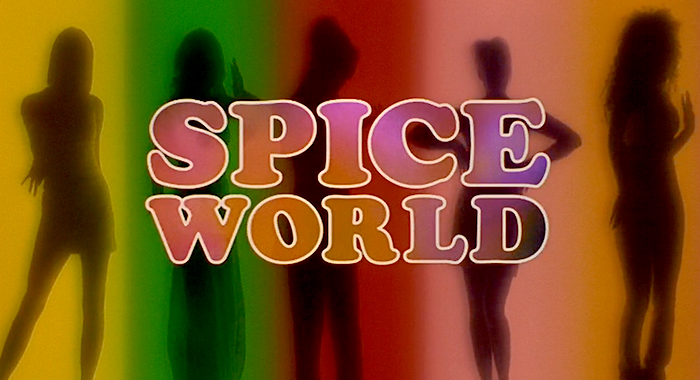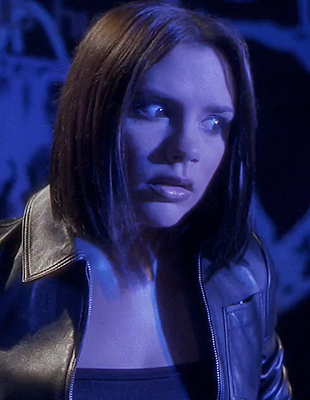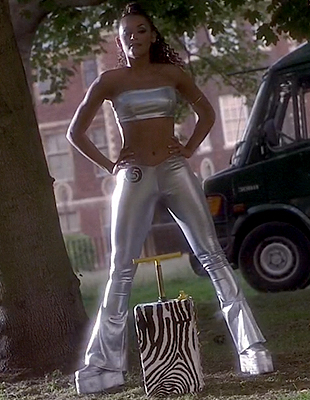
The early 1990s were a curious and amazing time to come of age as a pop music obsessive. I feel both blessed and cursed to have entered my teenage years in 1990. On one hand, I had cultural touchstones like Nirvana’s Nevermind, Dr. Dre’s The Chronic, and De La Soul’s 3 Feet High And Rising to teach me perfection. At the same time, the era was ruled by a peculiar puritanism that insisted that, contrary to the strongly held convictions of previous generations, pop music was not fun, and was not supposed to be fun, and that if pop music was caught being fun, then it should politely excuse itself and return wearing a flannel shirt and too much black eyeliner, mumbling something about the ineffable misery of everyday existence and how much it hates its parents.
Strange self-conscious obsessions with ethics and authenticity plagued pop music at the time, and artists were burdened with having to pretend that their strong sense of personal integrity were informed by the anti-corporate puritanism of Ian MacKaye — even if, like all decent Americans, they’d much rather listen to The Monkees’ Greatest Hits than Minor Threat.
All of the reasons people had historically gotten into pop music before — money, sex, fame, drugs, an overbearing stage parent — were suddenly considered crass and unacceptably mercenary. No, people were inexplicably — and, I think, nonsensically — supposed to get into pop music solely for self-expression, for the sake of their art, to carry on a noble tradition that dates back to Lou Reed, John Cale, Alex Chilton and those other guys who were in Big Star, Sid Vicious, Joe Strummer, and so on. It was ultimately tedious, untenable, and unfair to audiences and musicians alike. It was unfair because it robbed pop stars of their inalienable, god-given right to be tacky and mercenary and vulgar and wantonly sexual in a calculating way and kitschy and fun and whoever the hell they wanted to be, whether it fit within the parameters of “authenticity” or not. And it robbed fans of the right to be horny and dumb and immature and tacky and all the other things that make pop music so much fun.
 |
Are the Spice Girls in on the joke? Is there even a joke? |
Then came the Spice Girls to remind a world obsessed with authenticity that pop music was supposed to be about having a good time, that it was supposed to be sexy, plastic, silly, and nothing to take seriously. And if the group’s vibe and sound and image were unmistakably tacky, pre-fabricated, and silly, well, despite what the authenticity police of the early 1990s would tell you, that was no crime. Plus, they offered something for everyone: tight outfits and winking sexuality for the dads, girl power (as in feminism with fewer ideas and more wonder-bras and spandex) role models for girls not enthralled with the Courtney Love school of femininity, and hummable anthems to work out or dance to for gay guys and moms on the go.
The women’s nicknames doubled as descriptions of their persona. Geri “Ginger Spice” Halliwell was all about bosomy sass, although her solo career unintentionally disproved the old maxim about sex selling. Emma “Baby Spice” Bunton trafficked in an aggressively child-like sexuality (think Lolita, but skewing much younger). Victoria “Posh Spice” Beckham was all about icy aristocratic condescension. Melanie “Sporty Spice” Chisholm lived life as if it was one giant spin class she was intent on winning and earned her nickname because “Ambiguously Lesbian Spice” was just a little too progressive for the time, even for a group as gay-friendly as the Spice Girls (honestly, it would not surprise me to learn that “Sporty Spice” was played by a gifted transvestite the entire time). Lastly, Melanie “Scary Spice” Brown earned her nickname by virtue of being black, and what’s scarier than the unimaginable horrors white society has afflicted upon black people throughout the centuries, whether through slavery, institutionalized racism, or just individual bigotry?
Spice World, the first and, it should be noted, final cinematic vehicle for the Spice Girls, arrived at a strange, uncertain time for the group. The initial flush of their enormous worldwide success had passed. They were still huge, but they weren’t quite the white-hot pop culture fad/phenomenon they once were, and the days of what could very generously be deemed their “classic” line-up — the one with Geri Halliwell, the first to bolt by trading group success for solo failure — were rapidly coming to an end.
The film’s tone reflects that uncertainty. Its existence implicitly asks a bunch of questions the film doesn’t seem prepared to answer. Are the Spice Girls in on the joke? Is there even a joke? Are they a tongue-in-cheek post-modern goof reveling in their own artificiality or a spunky exemplar of girl power worth celebrating non-ironically?
To aid the Spice Girls in this quest to determine who exactly they were, before expressing that truth cinematically, the women had the earlier example of the Beatles, who engineered the perfect post-modern tribute to — and parody of — the kooky mechanics of pop superstardom with 1964’s A Hard Day’s Night, and the Sex Pistols, who, minus one John Lydon, navigated this territory much more shakily, but with utterly compelling results, with its even more aggressively post-modern, reality-blurring movie The Great Rock And Roll Swindle. But the Spice Girls were most assuredly not the Beatles or the Sex Pistols, and the film they made all too accurately conveyed the massive gulf in quality and significance between them and these giants. And oh boy, does Spice World borrow shamelessly from the Hard Day’s Night template.
 |
Richard E. Grant steals scenes through furious exertion as the group’s perpetually overwhelmed manager. |
We see the Spice Girls as the world sees them, and Spice World is considerate enough to provide a series of different filters through which to process the pop culture phenomenon. There’s an oily, malevolent paparazzi press out to sell papers by breaking up the band; they’re represented by a Rupert Murdoch-like mogul played by Barry Humphries and his chief henchman, a paparazzo with Jason Bourne-like skills played by The Rocky Horror Picture Show’s Richard O’Brien.
Then there’s a documentary crew headed by a character played by Alan Cumming, who sees the Spice Girls phenomenon through the thuddingly earnest lens of breathless documentary ambition, and a pair of filmmakers played by George Wendt and Mark McKinney who try to crack the idea of a cinematic vehicle for the Spice Girls throughout the film. The latter pair ultimately succeed in an end-credit sequence, where the film doubles back on itself and becomes about the fictional filmmakers making the real movie we’ve just seen (is your mind blown yet?).
Englishness is an essential part of the group’s brand, and in Spice World, they play it to the hilt; their vehicle is a double-decked bus emblazoned with the Union Jack that is infinitely bigger on the inside than it appears from the outside. Roger Moore is one of an endless series of winking cameos as “The Chief,” a dashing international man of mystery forever petting a cat and dispensing nonsensical bromides to his underlings. The film’s tone of appropriately English camp, though, proves quickly exhausting and reveals a limited comic sensibility, especially when executed by amateurs like the Spice Girls.
As a result, Spice World feels unmistakably like a 1970s variety show full of Family Guy-style cutaway gags, campy celebrity appearances from cornballs like Meat Loaf who stop just short of breaking the fourth wall and winking at the camera to show how in on the joke they are, and broad caricatures like a demented old British military man who is also a choreographer.
The film establishes its quintet of empowered women as the mildest of rebels, who are asked time and again to do something cheesy and lame, only to offer a moderate protest by doing something similar but slightly more suited to their style. Like the Beatles in A Hard Day’s Night, they are forever itching to bust out of the confines of pop stardom and the inhuman pressures of maintaining a squeaky-clean teenybopper image, but that really just adds up to the women wanting to spend time with a pregnant friend who symbolizes their pre-fame lives and maybe singing and dancing in environments more spontaneous than they’re used to.
Through it all, Richard E. Grant steals scenes through furious exertion as the group’s perpetually overwhelmed manager; everyone else is in Spice World, but he rather nakedly angles to reorient the film’s focus (successfully, for the most part) so that it might as well be Richard E. Grant World. Heaven knows he does all the heavy lifting comedically, and while everyone else is playing it as broad as a variety show, he’s sweating his way through the film in a manner that suggests he collapsed in a lump the day shooting ended and didn’t wake up for a week.
 |
Spice World is tepid, little more than a series of arbitrary musical performances strung together with campy foolishness. |
Spice World is tepid, little more than a series of arbitrary musical performances strung together with campy foolishness. The film views the idea that anyone might want more from the Girls than silly escapist fun with suspicion; in his non-starting sub-plot, Cumming’s pretentious documentarian says he wants to “Crash through the show-biz facade,” but Spice World, the cinematic equivalent of a fan magazine (and about as satirical and biting as one), is content with respectfully leaving the show-biz facade intact. The Spice Girls helped liberate the pop world from the dreary dictates of grungy obsessions with authenticity and realness, and I will forever be thankful to them for that. But once you have established yourself as the most artificial of fizzy pop phenomena, you can’t then try to double-back and make some dubious claim of authenticity.
Accordingly, no scene in this goofy movie is sillier, more ridiculous, or more preposterous than the one that professes to show the Spice Girls before they became the Spice Girls, when they were just a group of hungry up-and-comers singing for their supper by performing a scruffy version of “Wannabe” for a jazz-loving early benefactor. In this flashback, their costumes, attitudes, and personas all feel, if anything, far more insincere and contrived than what they wear as superstars, whose every move and look is carefully cultivated by trained, highly paid professionals.
Spice World is a pleasant mediocrity in large part because the music is such dumb, bubblegum fun, closing with a sassy performance of “Spice Up Your Life,” the big monster single from the soundtrack. It’s a song I will always associate with my baby sister; she’s a professor now, having recently graduated with a doctorate from Yale, but at the time of Spice World, she was just an unironic pop fan with a serious jones for that particular jam.
Hearing the song again engendered a pleasant burst of nostalgia as I reflected back on the simple pleasure pop music provides. Spice World’s appeal is almost entirely attributable to nostalgia, and musical nostalgia is perhaps the purest and most powerful pop culture form. But the 85 eminently forgettable, cheekily bland minutes leading up to this blast from the past underscore the limitations of nostalgia as well, and in the cold light of day, in the year 2016, when the Spice Girls are less the hot new thing than an oldies nostalgia act, Spice World hits those limitations hard.
Original Certification: Rotten
Tomatometer: 36 percent
Re-Certification: Rotten
Nathan Rabin if a freelance writer, columnist, the first head writer of The A.V. Club and the author of four books, most recently Weird Al: The Book (with “Weird Al” Yankovic) and You Don’t Know Me But You Don’t Like Me.
Follow Nathan on Twitter: @nathanrabin